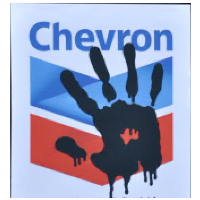Lawsuit Calls Out Air Board over Permit for Chevron Refinery Expansion in Richmond

Chevron Corp. was already in the construction phase of a big expansion at its Richmond refinery in 2008 when a judge ruled its environmental impact report (EIR) was grossly deficient and halted the project.
Although a major fire that exploded in a fireball―emitting dangerous fumes and sending 15,000 nearby residents to hospitals in 2012―put a crimp in their plans, the company continued to push for a scaled-down $1-billion upgrade while it renewed the original permit granted by the Bay Area Air Quality Management Board (AQMD).
On Thursday, attorneys for Communities for a Better Environment filed a lawsuit against the agency for renewing the permit twice based on the discredited EIR. “The Air District has acted prematurely and essentially put the cart before the horse,” the lawsuit reads. “The Air District granted Chevron an air permit for the Chevron Modernization Project, prior to even the release of the draft EIR for the Project.”
The court tossed out the city of Richmond’s land use permit when it bagged the EIR in 2008 for, among other things, insufficient air emissions analysis and mitigation. But the AQMD, which based its permit on the EIR, did not revoke Chevron’s “Authority to Construct” (ATC).
Richmond released a draft version of the EIR for public comment and review in March, while Chevron continues to set its sights on a 2016 project completion date.
Although Chevron calls the project a “modernization,” critics call it an “expansion.” The changes ostensibly won’t increase the refinery’s capacity, but will allow it to process dirtier oil without, it maintains, spewing more pollution into the atmosphere than it already does.
Critics say the refinery already poses a major health threat to the community and this will make it worse. Chevron’s assurance that its project is environmentally neutral relies to some extent on its buying carbon credits in the state’s cap-and-trade program, giving money to the city’s greenhouse gas reduction programs and making other onsite environmental improvements.
The draft EIR says the modernization would emit an extra 1 million tons of greenhouse gases a year. Chevron pegs that climate-change contributor’s increase at 15%.
At the heart of the argument is what kind of oil Chevron is going to be refining in Richmond. The company says it will be from sources that have higher sulfur content, which generate more pollution without the application of new technology. But it denies that it will bring oil from the tar sands of Alberta, Canada, or fracked oil from North Dakota’s booming Bakken fields.
Tar sands are the dirtiest fossil fuel on the planet and Bakken crude is plenty filthy. Both would have the added disadvantage of arriving by rail, a dangerous prospect.
Railroads are carrying 25 times more crude oil nationally than they were five years ago and the increase is reflected in oil spills. Around 792,600 gallons of oil were spilled in train accidents from 1975 to 2012, according to the U.S. Pipeline and Hazardous Materials Safety Administration (PHMSA). That total nearly doubled in 2013 to 1.3 million gallons.
The Richmond facility currently receives its crude via tanker and Chevron denies it plans to change that. But the company also hasn’t specified exactly where the oil would come from.
–Ken Broder
To Learn More:
Environmental Group Sues Air District over Chevron Richmond Project Permit (by Robert Rogers, Contra Costa Times)
Suit Seeks to Halt Plans for Richmond Oil Refinery Expansion (by Bob Egelko, San Francisco Chronicle)
Chevron Tries Again with Richmond Refinery Revamp (by Molly Samuel, KQED)
Richmond Protests and Sues Chevron on Anniversary of Devastating Refinery Fire (by Ken Broder, AllGov California)
Communities for a Better Environment v. Chevron (San Francisco County Superior Court of California) (pdf)
- Top Stories
- Controversies
- Where is the Money Going?
- California and the Nation
- Appointments and Resignations
- Unusual News
- Latest News
- California Forbids U.S. Immigration Agents from Pretending to be Police
- California Lawmakers Urged to Strip “Self-Dealing” Tax Board of Its Duties
- Big Oil’s Grip on California
- Santa Cruz Police See Homeland Security Betrayal in Use of Gang Roundup as Cover for Immigration Raid
- Oil Companies Face Deadline to Stop Polluting California Groundwater





